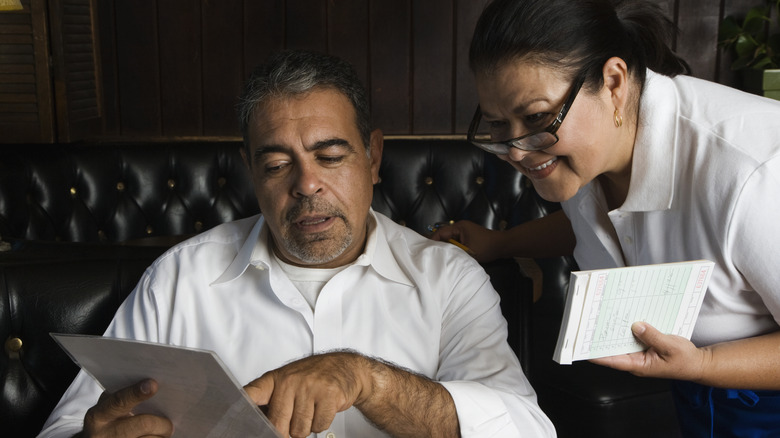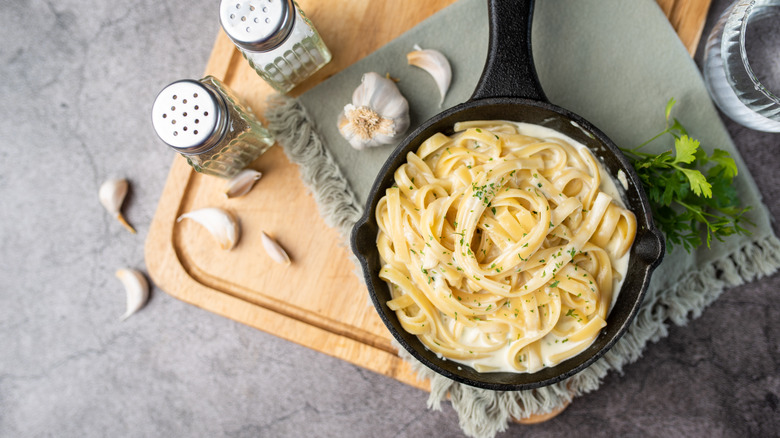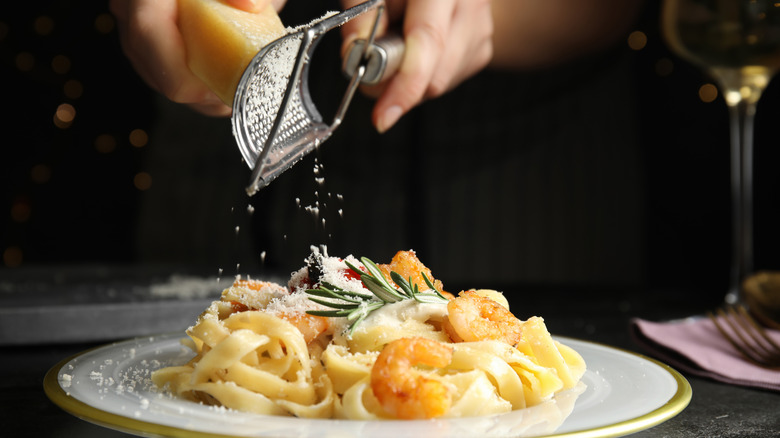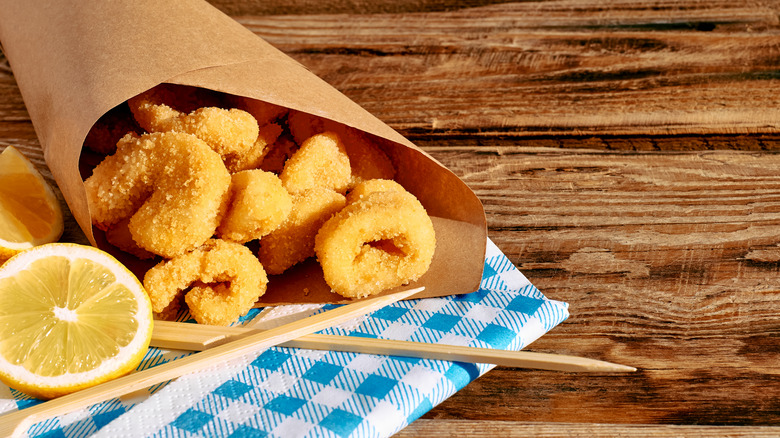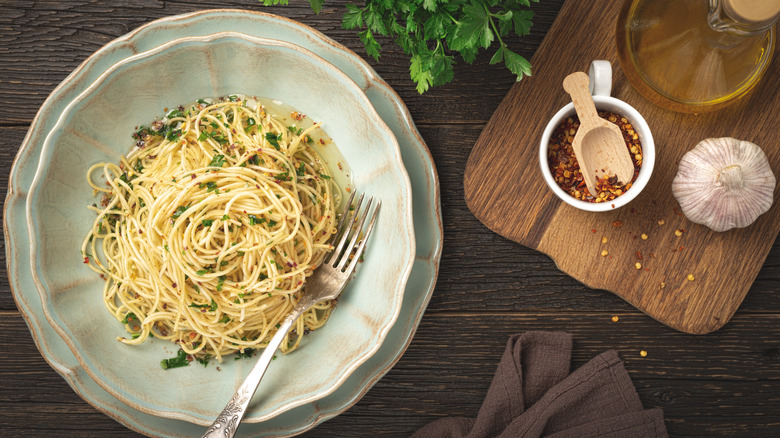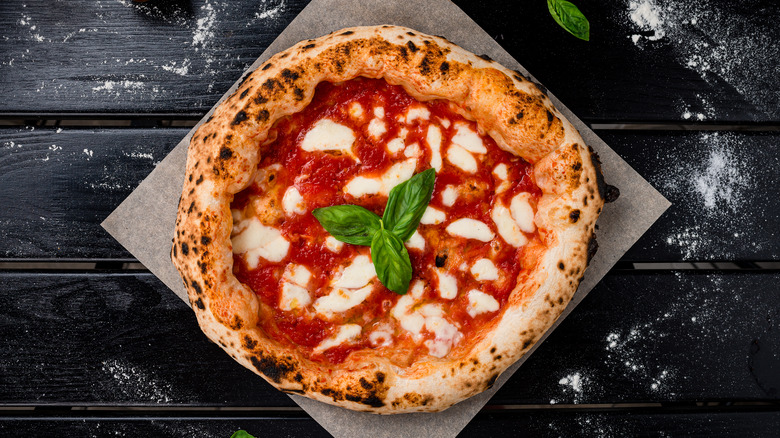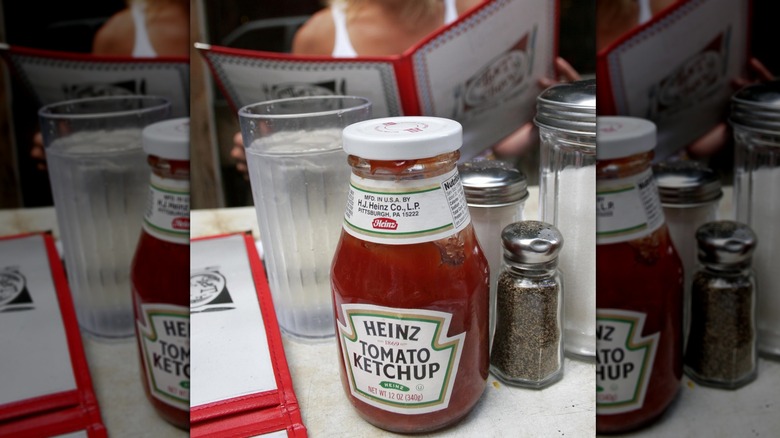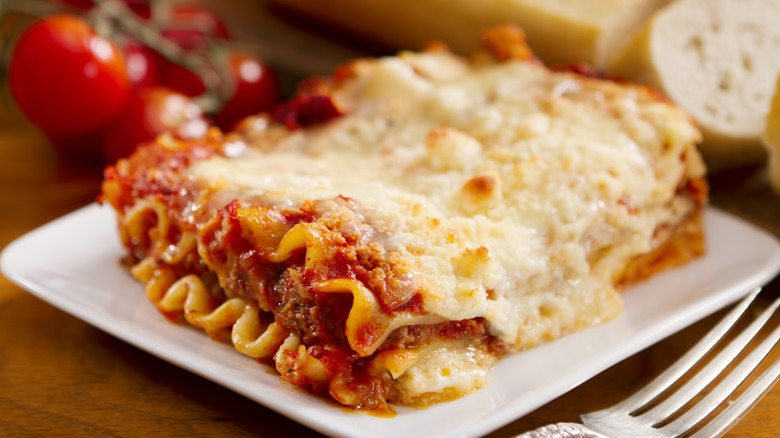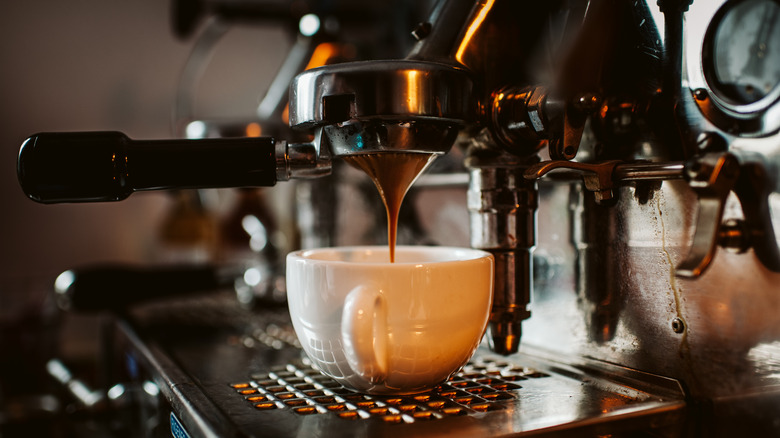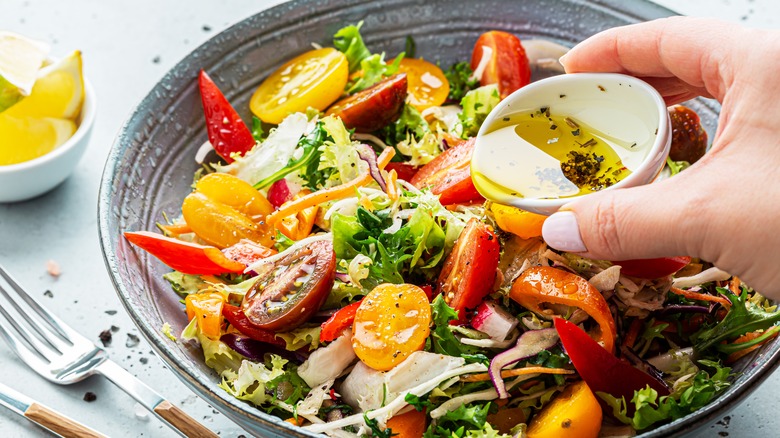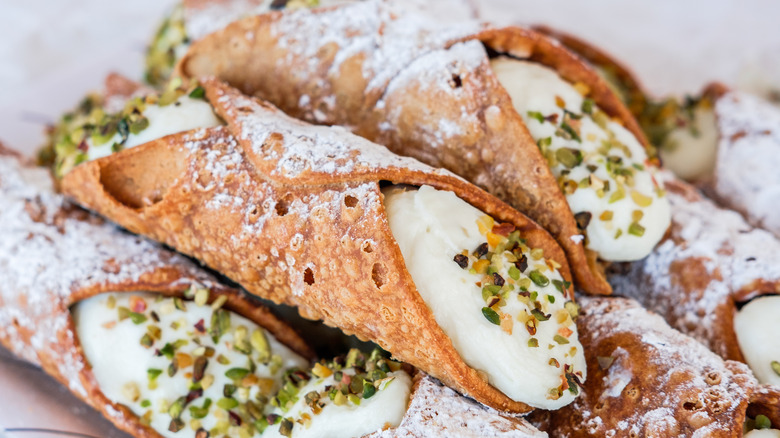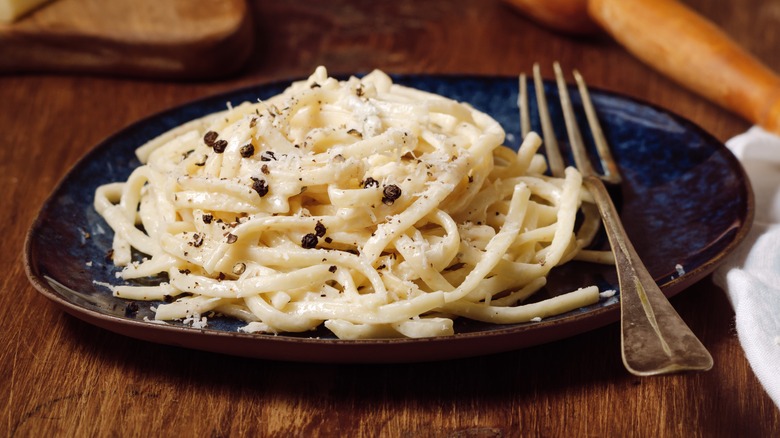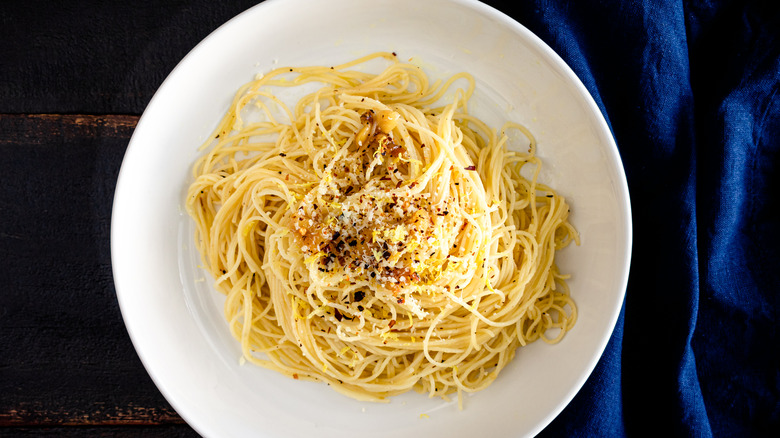15 Mistakes To Avoid When Ordering Italian Food
No matter where you live in the U.S., you've probably walked into an Italian restaurant dozens and dozens of times. You probably even have your go-to order, whether it's ravioli, chicken parm, or penne alla vodka. But as any Italian-American will tell you, there are some key things to avoid when ordering Italian food. Specifically, if you're at an authentic place, not doing these things will help you gain some cred. If you are the type of person to throw caution to the wind and enjoys mispronouncing menu words and ordering questionable items, that's your loss. Putting in a little bit of effort is only going to make your dining experience better.
Most decent Italian restaurants in America will have white tablecloths, a bowl of mints by the entrance/exit, as many homemade items on the menu as possible (specifically look for the pasta sauce being homemade), and at least a few patrons in the restaurant who know all the staff. Hey, if people keep coming back for more, that's a good thing. Here are the mistakes to avoid to make the best of your Italian restaurant experience and order like a pro.
1. Mispronouncing gnocchi
Yes, words in Italian can be hard to pronounce sometimes, especially if they are super unfamiliar to you. But other times, the word simply doesn't sound like the letters in it exist at all. This is the case with gnocchi. If you read that just now in your head as "g-knock-ee," we're sorry to report that's just dead wrong. Apologizing on behalf of Italians everywhere, we're here to tell you that it is pronounced nothing like the way it is spelled. Isn't that fun?
You should be pronouncing this potato-based pasta type as "en-yolk-ee" rather than any other way of saying it. The faster you say it, the more Italian you sound. And if the moment comes, and the waiter is looking at you waiting for you to order, and you're staring at that darn menu item with contempt, just take the L and point at the item on the menu to show them what you want to eat. But to avoid that stressful ordering moment, take a second to practice saying gnocchi out loud, or even practice with an Italian friend. It's a simple word to say once you get the hang of it.
2. Getting Alfredo sauce
Though other favorites you probably ordered as a kid are still delicious and nostalgic today (read: mac and cheese, chicken tenders, french fries), others just don't have the same magic and flavor as they did growing up. Case in point? Alfredo sauce. Now, let's get things straight: We're not here to hate on Alfredo sauce. In fact, we think an Alfredo sauce done right is a delicious and memorable option that you should definitely select at a restaurant. But at most Italian restaurants throughout the U.S., getting the Alfredo sauce is a mistake.
Though it's probably an okay sauce, and you won't keel over if you order it, you can actually (in most cases) make it better yourself at home. There are so few ingredients in Alfredo sauce that it's easy to become lazy with it, which is what we've found happens in a lot of Italian restaurants. It's a cost-cutting, throwaway dish that most chefs don't spend time perfecting, which means you'll be getting a higher-quality meal if you order something with a different sauce.
3. Not customizing your pasta
This next tip isn't about an Italian food item you should or shouldn't order, but rather a strategy you may not have thought of before. If you adore vodka sauce, but the one item featuring it on the menu is a penne alla vodka, and you detest penne pasta, there is no harm in switching it up. Ask the waiter if it's possible to get another pasta done in the vodka sauce. Be sure to actually choose another pasta type that's already featured on the menu, like spaghetti, rigatoni, or ravioli, and then the chances are pretty high that the kitchen will be able to accommodate your request.
The worst that can happen is that they aren't able to do it for you, in which case means that they're probably pre-making and mixing the pasta and sauce together, which we think is a bit of a red flag (it can make the pasta mushy and less fresh if it sits in the sauce for hours). A nice-quality Italian place will be able to customize your pasta and sauce combination ask, as long as those items are on the menu. Similarly to adding chicken to the top of a dish, it's an easy, non-time-consuming task for the chefs to do, and we promise they won't hate you for it. And if you're too shy to ask the waitress yourself about your request, have a bolder friend at the table do it for you.
4. Dumping a ton of Parmesan on seafood pasta
Do you love letting that waiter go to town on the "I keep grating this cheese until you say stop" schtick? We do, too. The taste of the sharp Parmesan on top of that warm, savory sauce creates the perfect cheese pull that adds a whole other dimension to your dish. And even if you're at a spot that keeps the Parmesan on the table in a shaker, it still needs to go on top of your pasta dish — it wouldn't feel complete without it. It's the metaphorical cherry on top. But we'd advise you to pass on the Parmesan for seafood pasta dishes specifically.
Sadly, though we all love Parmesan, it actually isn't doing anything for your light, seafood pasta dish. In fact, more than not adding to the situation, it's actually taking away from the quality of your dish. If you want to get the full effect of the flavors and hard work the chefs put into your dish, you have to skip the cheese. This is because Parmesan specifically has such a strong flavor, and when put on top of light seafood like crab or lobster, it masks the delicate flavors of the seafood.
5. Putting calamari in a to-go box
Ordering the calamari at an Italian place is an easy win. You know it should be good at pretty much any authentic place you go, and we think it's one of the most perfect appetizers you can get. It's crispy, has a great sauce to dip it in, is easy finger food but can also be classed up by picking it up with a fork, the pieces are already bite-sized, and the squeeze of lemon overtop adds just a touch of zing, and calamari is overall the perfect Italian restaurant appetizer to order.
Unfortunately, it is not the perfect Italian restaurant appetizer to take home with you. Whether you're sitting down at the restaurant and you (somehow) didn't finish your calamari so you're considering taking it to-go, or if you're ordering some Italian food for a night-in at home, skip the calamari in a to-go box. This goes for most fried foods, but calamari gets so soggy once it's put in that box. You're better off trying to finish eating it at the restaurant, or if you're ordering pickup or delivery, just save the calamari ordering for when you're there in person. Trust us, you'll save your money and your appetite for items that transport better.
6. Assuming a dish is garlic-free
It's pretty commonly well-known that Italian food is generally heavy-handed with garlic. And it makes sense why; garlic blends really well with other popular Italian seasonings, like basil, oregano, and thyme. To further the point, garlic always accentuates a delicious homemade tomato sauce, bringing out the acidity of the tomatoes. But whether you have a sensitive stomach to garlic or are just allergic to it, you should assume garlic is in every dish in the restaurant, even if it's not in the ingredients list of the item on the menu.
In fact, garlic is pretty much in the air at most Italian spots. Though you may not find pieces of garlic chopped up or minced swirling around in your sauce, it's still in there. You can often find garlic in the butter for the bread on the table, in any of the sauces you order blended in there, and even in the olive oil used in most dishes. If you're looking to avoid garlic, we think the safest thing you could order at an Italian restaurant would be a soup or salad. It's just how Italians cook.
7. Going for the margherita pizza
We've spent an awful lot of time talking about pasta so far, so let's switch gears a bit to another incredibly popular Italian food you'll see on most menus: pizza. The Italian's form of bread and cheese in a dish, pizza is so easy to get right, yet also so easy to get wrong. If you're at a place known for its pizza, and the margherita is a highly-regarded, crowd favorite there, we don't see any harm in ordering it. But at your average Italian place where pizza maybe isn't the main focus of the menu, or the margherita pizza seems like a menu afterthought more than the star, you could probably benefit from ordering something else.
We'll let you in on a little secret: Margherita pizza is in the same camp as Alfredo sauce, meaning that it's so easy to make that chefs often don't spend the time or energy on making it excellent. This means that you're more likely to get a high-quality meal by ordering another type of pizza, instead of the one they can throw mozzarella slices and chopped tomatoes on in the oven and then put cold, dry basil leaves on top. It's just disappointing, and you can avoid that disappointment by ordering something else.
8. Asking for ketchup
Everybody makes mistakes sometimes, sure. And everyone has messed up before ordering at Italian restaurants (we wouldn't be writing this article if that weren't true). But asking for ketchup at an Italian place? Truly criminal. What are you doing? Unless you're in Japan or another part of the world where there are specific dishes that combine pasta and ketchup, just don't do it, okay?
The most likely scenario we can think of this coming up is if a child at your table is hesitant to try new foods, and that red sauce on the pasta is looking pretty intimidating. To a child's eyes, perhaps that familiar and safe ketchup they eat with chicken tenders and french fries is close enough to pasta sauce, so they ask for ketchup. We know sometimes that accommodating a child's food request is important, and we will give you that, but please avoid ordering ketchup for their pasta if at all possible. It's like a crime against Italian food. If anything, just get them something off the kids' menu, just don't ask for plain noodles and ketchup; it's gross.
9. Expecting lasagna to be amazing at every Italian restaurant
Are you dreaming of your mom's homemade lasagna recipe fresh out of the oven? If you are craving that nostalgia and quality in a dish, we think your best bet is to skip ordering it at a restaurant. This isn't to say that most Italian restaurants make a bad lasagna — it's actually probably decent. It's just that the circumstances surrounding lasagna in a restaurant prevent it from being the best it can be.
If you've ever had a days-old, sitting in the refrigerator, piece of lasagna heated up in the microwave, you'll know that it just doesn't hit the same as it does right when it's out of the oven. The sauce is pretty dry, the noodles aren't as fresh, and the cheese isn't as melty. It's an all-around mediocre, if not unpleasant, experience that is not comparable to what fresh lasagna tastes like. Getting the lasagna at a restaurant is a similar deal: Who knows how long it's been sitting out on the counter for since it's been baked, especially since you're only getting one piece of it. You're better off ordering something else that you know is fresher.
10. Skipping the after-dinner coffee
This tip is strictly for Italian restaurants in America, and should not be applied to restaurants when you're in Italy. When in Italy, should you get the chance to go, it's customary to not order an after-dinner coffee at all, especially milk-based ones like cappuccinos. It's just not how they do things there, as they see such a heavy, dairy-loaded drink to weigh you down before bed. But when in the U.S., you'll find that many older Italian-Americans especially enjoy having a nice cup of coffee after their dinner. We happen to agree with them for a few reasons.
First of all, a nice after-dinner cappy (cappuccino) just completes the meal and offers a palate cleanser to your mouth. No one wants to drive home with the taste of sauce in their mouth (yuck). It's actually true that when smelling candles at a store, you should smell coffee beans in between scents to clear your palate and have a little sensory reset. We find the same is true for an after-dinner coffee. Aside from being a fun tradition and relaxing way to end your meal (you can always get decaf if you want to participate but can't do caffeine past a certain time), we find that coffee and dessert go together really well.
11. Requesting a salad dressing other than the house
Whether your meal comes with a side salad or if you're at a place that automatically brings you a big salad for the table before your main meal (we love those kinds of places) you're probably going to be asked what kind of dressing you want for it. In our humble opinion, you can have ranch, Caesar, French, or any generic dressing any day of the week. You can buy those easily from your local grocery store and make that salad at home. Do you know what you can't easily make at home? The restaurant's house dressing.
Especially if you're at an Italian place, the house dressing is bound to be good for several reasons. First of all, the place is making it in a large batch and serving it to lots of people, and if the dressing is bad, the restaurant would be losing money on it, so it's bound to be good. Second, it's probably (definitely) homemade, which means it's bound to be delicious and likely a secret recipe. If the spot doesn't happen to have a house dressing (red flag), then you can order whatever dressing you want to your heart's content, but before reflex-ordering the ranch, ask if there's a house dressing; you won't be disappointed.
12. Ordering the cannolis when they aren't homemade
There are many ways you can get away with cutting corners at an Italian place and most customers simply won't notice, but one that you just can't get away with is the dessert. As a diner, you will absolutely be able to tell the difference between a homemade cannoli and a crappy pre-bought one (cough, cough we're looking at you Olive Garden). If the menu doesn't specifically indicate the cannolis are homemade, that's honestly already a cause for concern, because what restaurant doesn't want to show off its prowess and superiority in that its cannolis are homemade? But, some places don't like to flaunt, so if you see cannolis on the menu and are wondering if they're homemade or not, ask the waiter. If they seem unsure, you're better off not getting the cannoli for dessert.
This goes for most Italian desserts like tiramisu and zeppole, but for cannolis especially, skip the dessert if it's not homemade. The filling will taste off, the shell will be hard, and it will taste artificial. Maybe we're just cannolis snobs, but Alex Guarnaschelli agrees with us that homemade cannolis are superior, so take her word for it.
13. Sipping the wrong wine with your meal
This next tip goes for any type of cuisine, but it's especially important to keep in mind regarding Italian food. When the flavors are as bold as most Italian ingredients like prosciutto, sharp cheeses, and homemade pasta, the last thing you want is your wine (literally) putting a damper on your meal. If your dish is a light, airy, lemony seafood pasta, ordering a dry red will kill your vibe (and your tastebuds).
To avoid mishaps like these, you have to make a game-time decision in one of two ways. The first strategy you could employ is having your meal already chosen in your head when you're ordering your wine. That way, you'll be picking your wine based on your main dish, with no tastebud catastrophes awaiting you. The second strategy you can try is just ordering the wine you want to get, and then consulting our Italian comfort food and wine pairing guide (or your own knowledge) to choose the correct dish to pair it with. Whichever item you choose first, wine or meal, will depend on your preference, so let your cravings decide which one is leading the way.
14. Taking a chance on the cacio e pepe
You probably understand the name of the game now: Less money and effort often goes into items that are easy to make, and your dish will end up being less than satisfactory. Obviously, this is not a catch-all rule, as some restaurants slay at Alfredo sauce and margherita pizza. But, nonetheless, cacio e pepe sadly falls into this camp of Italian dishes. And it really is a shame, because when done right, cacio e pepe is absolutely delicious and one of our favorite pasta dishes.
A simple meal made from sheep's milk cheese, pasta, and pepper, cacio e pepe is all in the quality of ingredients used, the care taken to make the dish, and the attention to detail in the presentation. You can get a fantastic cacio e pepe at Eataly, actually, or any well-regarded Italian place that's known for its cacio e pepe, but if your local Italian restaurant has recently added it to its menu because it's trendy, it's probably not going to blow you away.
15. Selecting angel hair pasta
Angel hair pasta is one of our absolute favorite types of pasta, so this tip pains us to tell you about it. We think angel hair pasta should, in general, be even more popular than its rival spaghetti, but we understand why it's not. The reason it's probably not as popular is the same reason you may want to avoid ordering it at an Italian restaurant: It can easily become mushy after being cooked. It's called angel hair for a reason, and that's because it's so delicate.
We love how delicate the pasta is, but its beauty is also its downfall in a restaurant setting. Especially in places that are making food as fast as they can serve it, it's very easy for a delicate pasta such as angel hair to become soggy under the weight of too much sauce, sitting too long in the water, and/or sitting out too long in the kitchen. If you're an angel hair pasta diehard fan and are willing to take the chance to order it, we say go for it. But if you can live without it, you'll have better chances with a more durable type, like rigatoni or spaghetti.

